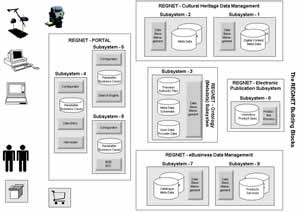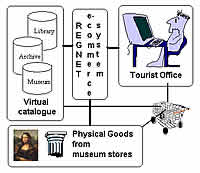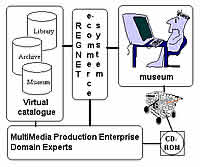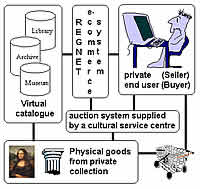
 |
|
|
|
|
|
|
|
|
|
|
| |
|
Member Area |
| |
| Information Society Technologies
(IST) Programme |

|
|
|
|

|
| Project Handout |

|
ABSTRACT
The concept of a European Digital Library cannot only
be based on a technical framework enabling access to digital
goods - there is also a need to introduce new ways of
cooperation between different stakeholders (Cultural Organisations,
Industries, Administrations, etc.) as well as to "re-engineer"
traditional business processes in the light of globalisation
and world wide markets. The main activities within a support
environment for I(nternet) Markets comprise: Content Engineering,
Platform Engineering, and Enterprise Engineering.
The REGNET - Cultural Heritage in REGional NETworks project
- targets to all of the three areas. The project was introduced
under the Action Line 'Access to digital collections of
cultural and scientific content' of the European Union
IST-Information Society Technologies Programme and 23
partners, cultural organisations (museums, libraries and
archives) and IT-industry representatives, from 10 European
Union states as well as Bulgaria and Russia are participating. |
 |
ENVISAGED ACHIEVEMENTS
REGNET will set up a functional network of cultural service
centres through Europe which will provide IT-services
dedicated to cultural heritage organisations. A technical
and legal framework, the REGNET system, for such a service
infrastructure will be developed. This will offer services
like data entry, search and retrieval, and e-Business.
It will be based mainly on integration work using state-of-the-art
components. The network will integrate multi-media industries,
content providers and service centre operators. Existing
cultural infrastructures will be exploited and new infrastructures
should be developed where necessary.
The technical infrastructure should allow to set up even
low cost service centres. The membership concept of the
service centres will generate a critical mass of digital
or physical goods contained in Content Provider's organisations. |
 |
THE PLAYERS WITHIN THE NETWORK
The four players within the network are the content providers,
the service centre operators, the system developers and
the end users. The content providers (museums, libraries,
archives etc.) will provide access (via wired and wireless
communication) to their digital contents, services and
products and offer them to their clients (B2C). In return
they can use the REGNET facilities for multimedia productions
and data base management, or cooperate with other REGNET
partners during the creation of data bases, generation
of multimedia products or creation of a virtual exhibition
(B2B). The service centre operators will generate income
by providing the technical infrastructure (software/hardware)
to content providers and other partners within the REGNET
network. They offer additional IT-services and consultancies.
And the system developers are selling the REGNET system
to other cultural service centres and content providers.
They implement additional components for the REGNET software
system (additional 'nodes' like an 'exhibition creator',
etc), and will generate income via licence fees for the
REGNET system. For the end user the system will offer
easy and wide access to cultural heritage data information
and the purchase of CH related goods and services at one
point, with stress on the production of personalized goods
(e.g. CDROM) and services. |
 |
THE REGNET SYSTEM ARCHITECTURE
The building blocks which constitute the REGNET-System
are supporting access to cultural & scientific information
as well as to product & service information offered
by different organizations. The building blocks are outlined
in the figure below. The REGNET-Portal enables entry of
remote data, distributed search and e-business functions.
The Cultural Heritage Data Management allows the search
in distributed metadata repositories connected to data
of cultural heritage content. The e-Business Data Management
gives access to distributed goods and services catalogues
via an e-business system. And the Ontology Checker contains
specifications of metadata, terminologies etc. which are
used in the e-business and cultural heritage field.
 Finally
the Electronic Publisher allows the production of personalized
digital products based on standardized metadata and work
flows. Finally
the Electronic Publisher allows the production of personalized
digital products based on standardized metadata and work
flows.
REGNET extends the traditional access facilities to distributed
heterogeneous catalogues by integration of product and
service catalogues managed by e-business systems. Because
of the large REGNET consortium real world tests covering
6 European regions (a dozen states) are possible.
The project will observe and take into account the ongoing
and recent work of CEN/ISSS (Electronic Commerce Workshop)
but will also look into recent activities like RosettaNet,
eCo-Framework, OBI, etc.
REGNET will evaluate a networked organisation model (comparable
to the Art Museums Image Consortium/AMICO in the United
States) and the integration possibilities of tools and
systems for co-operative working
|
 |
STANDARDS AND METADATA
REGNET will also provide a unique facility to meta data
definitions for both CH-related data and e-business related
data via the search entry in the REGNET - Portal and the
REGNET - Ontology subsystem. Here not only meta data related
to objects is addressed, but also definitions of work
flows, business processes, etc. are included which lead
to the concept of Ontology within the Cultural Heritage
domain. Within the project a data entry facility using
WEB-browsers and adaptable to different needs within different
domains (Museums, Library, Archives) will be established.
This facility will support existing standards (ICOM/CIDOC,
UNIMARC, ISAD(G), etc) and is configurable by the REGNET
System user. At the e-Business level REGNET provides the
generation of a customised shopping cart systems within
the business to consumer (B2C) framework |
 |
MOBILE ENTRY
It will be examined how next generation mobile networks
can be exploited to widen the potentiality of WEB services
in the field of Cultural Heritage. Appropriate gateway
functions and interworking units will be envisaged to
interface the REGNET architecture with the UMTS (Universal
Mobile Telecommunication Systems) structure and ensure
a seamless provisioning of REGNET services to mobile customers. |
 |
ELECTRONIC CATALOGUES
Already existing electronic catalogues (OPACS: Online
Public Access Catalogues) referring to cultural &
scientific objects contained in libraries, museums, archives,
and galleries, as well as to goods and services will be
used. Where there are no catalogues yet new catalogues
will be developed in order to establish a 'virtual union'
catalogue of all OPACS and product/service catalogues
held locally. |
 |
BUSINESS ENGINEERING
In addition the work includes the outlining of necessary
'supply chains' and the connected business processes and
functions to deliver digital and physical goods. All the
business transactions on the B2B and B2C level (containing
payment features, copyright systems, authentication control,
etc) will be guided by a legal framework that will be
worked out accordingly. The reorganisation of existing
processes and introduction of computerised functions which
make transactions for low money goods worth while (e.g.
small copyright fees for digital images) is an essential
part of the project. |
 |
USER SCENARIOS
The scenarios outlined below can be considered as a first
reference to e-Business processes only.
| Business to Consumer (B2C): |
Business to Business (B2B): |
Consumer to Consumer (C2C): |
 |
 |
 |
|
 |
MARKET SITUATION
Electronic commerce, notably business to business e-commerce,
is booming and world-wide e-commerce sales are expected
to grow 40 times between 1998 and 2003 by which time they
will become over 15% of all sales. The Internet and e-commerce
are also leading to a surge in new company creation. The
market for REGNET systems and services can to some extent
be reckoned by the number of museums, libraries and archives
in Europe. A rough estimation would deliver a potential
number of 3.000 (15% of 20.000 museums) museum shops throughout
Europe being candidates to be partner of the REGNET network! |
 |
|
PROJECT DETAILS
The project is a Research and Development project with
a Demonstration phase.
| Project Start: |
2001-04-01 |
FUNDED BY THE EUROPEAN COMMISSION |
| Duration: |
24 Months |
| Budget: |
5,038 Mio. EURO |
| Coordinator: |
AIT Angewandte Informationstechnik Forschungsgesellschaft
mbH |
| Type: |
Research and Development Project with Demonstration
Phase |
| Contribution: |
Cost Sharing (48,6% EU - 51,4% partners) |
| Partners: |
| AIT Angewandte Informationstechnik
Forschungsgesellschaft mbH (A) |
TARX nv (B) |
Zeus Consulting SA (GR) |
| Österreichische Nationalbibliothek
(A) |
Stad Mechelen - Stedelijke
Musea Mechelen (B) |
Systema Informatics Ltd.
(GR) |
| Salzburg Research Forschungs-gesellschaft
mbH (A) |
Stichting Museon (Museum
voor het Onderwijs) (NL) |
Centre for Research and
Technology Hellas (GR) |
| Universität Wien
(A) |
SPACE S.r.l. (I) |
VALTECH (F) |
| IMAC Information&Management
Consulting e.K (D) |
Fratelli Alinari I.D.E.A.
Spa (I) |
Terra Incognita Europa
Limited (GB) |
| Stockholms Universitet
(S) |
Consorzio Civita (I) |
Institute of Computer
and Communication Systems (BUL) |
| Länsmuseet på
Gotland (S) |
Motorola S.p.A. (I) |
Southern Ural State University
(RU) |
| Naturhistoriska Riksmuseet
(S) |
Ajuntament de Granollers
(E) |
|
| Kungl. Vetenskapsakademien,
Royal Academy of Science (S) |
Instituto Andaluz de Tecnología
(E) |
|
|
|
| |
|
|
|
|

